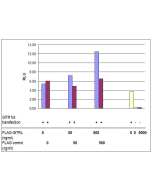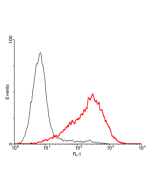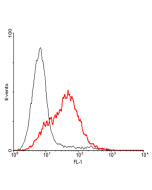Cookie Policy: This site uses cookies to improve your experience. You can find out more about our use of cookies in our Privacy Policy. By continuing to browse this site you agree to our use of cookies.
AdipoGen Life Sciences
anti-GITR (mouse), mAb (MGIT 02)
As low as
190
CHF
CHF 190.00
In stock
Only %1 left
AG-20A-0007-C100100 µgCHF 190.00

Figure 1: FACS: GITR-transfected HEK 293 cells stained significantly using anti-GITR (mouse), mAb (MGIT 02) (Prod. No. AG-20A-0007).
| Product Details | |
|---|---|
| Synonyms | Tumor Necrosis Factor Receptor Superfamily Member 18; Activation-inducible TNFR Family Receptor; Glucocorticoid-induced TNFR-related Protein; CD357; TNFRSF18; AITR |
| Product Type | Monoclonal Antibody |
| Properties | |
| Clone | MGIT 02 |
| Isotype | Rat IgG2aκ |
| Immunogen/Antigen | Recombinant mouse GITR. |
| Application |
ELISA: (direct and indirect: 1:5'000-1:10'000) Note: Tested on recombinant proteins and/or target-protein transfected cell lines in ELISA, Western Blot and/or FACS. |
| Crossreactivity | Mouse |
| Specificity |
Recognizes mouse GITR. Does not cross-react with human GITR. |
| Purity Detail | Protein G-affinity purified. |
| Concentration | 1mg/ml |
| Formulation | Liquid. 0.2μm-filtered solution in PBS, pH 7.4. Contains no preservatives. |
| Isotype Negative Control | |
| RRID | AB_2490089 |
| Shipping and Handling | |
| Shipping | BLUE ICE |
| Short Term Storage | +4°C |
| Long Term Storage | -20°C |
| Handling Advice |
After opening, prepare aliquots and store at -20°C. Avoid freeze/thaw cycles. |
| Use/Stability | Stable for at least 1 year after receipt when stored at -20°C. |
| Documents | |
| MSDS |
 Download PDF Download PDF |
| Product Specification Sheet | |
| Datasheet |
 Download PDF Download PDF |
Description
GITR is the receptor for TNFSF18. It is involved in interactions between activated T-lymphocytes and endothelial cells and in the regulation of T-cell receptor-mediated cell death. Mediates NF-κB activation via the TRAF2/NIK pathway.
Product References
- Soluble glucocorticoid-induced tumor necrosis factor receptor (sGITR) stimulates osteoclast differentiation in response to receptor activator of NF-kappaB ligand (RANKL) in osteoclast cells: H.H. Shin, et al.; Bone 36, 832 (2005)










